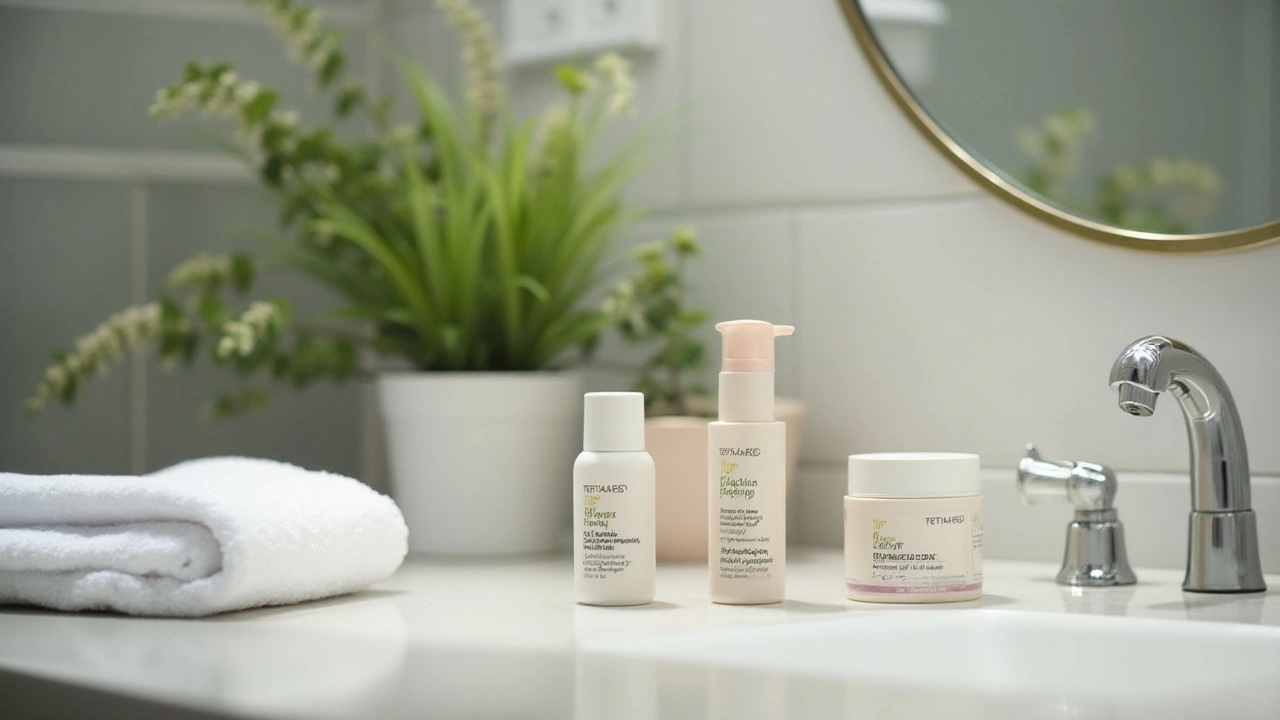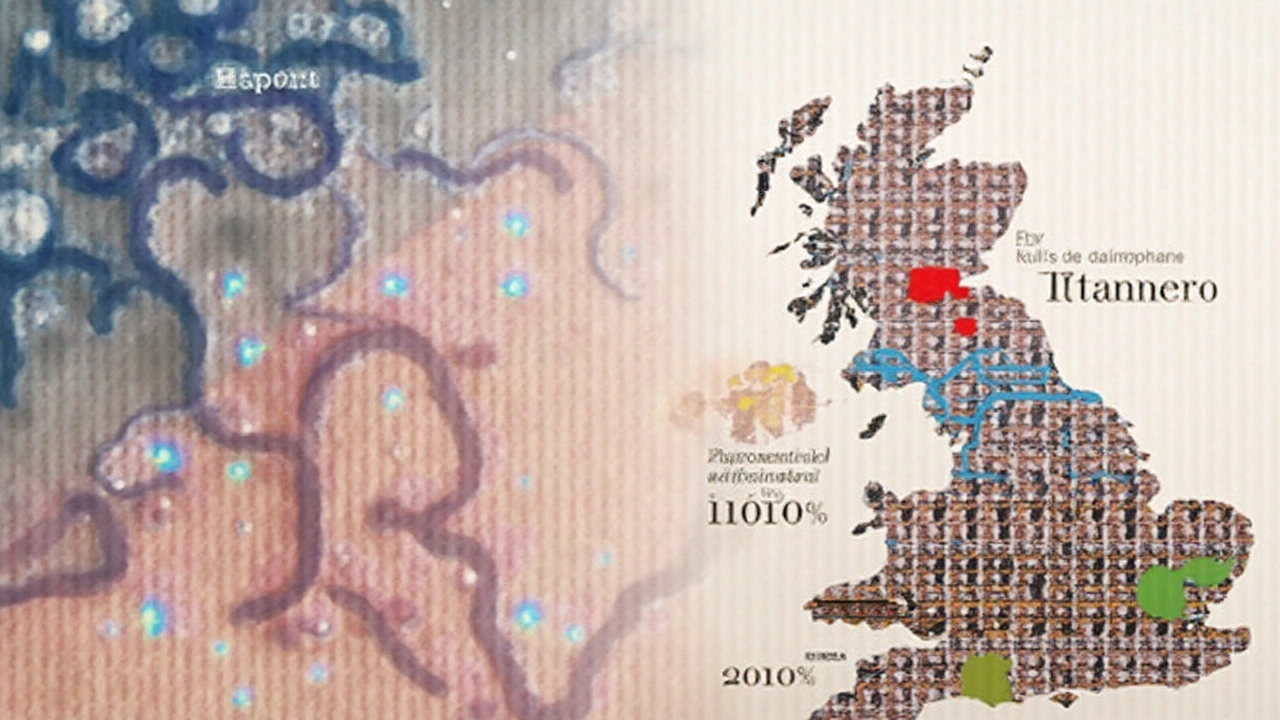Demystifying Hydroquinone, Mometasone, and Tretinoin: A User's Guide
 Jan, 7 2025
Jan, 7 2025
In the bustling world of skincare, ingredients like Hydroquinone, Mometasone, and Tretinoin often come into the spotlight for their transformative effects. Whether you're battling stubborn pigmentation, seeking to curb inflammation, or hoping to rejuvenate aging skin, these compounds offer an array of possibilities. Each plays a distinct role, yet their combined power can lead to healthier skin, if used wisely.
This article aims to demystify these three common yet often misunderstood components. By diving into their individual purposes and the synergy they create, we hope to equip you with the knowledge needed to harness their full potential. As with anything related to health, understanding is key to making the best choices for your skin journey.
- The Purpose of Hydroquinone
- Understanding Mometasone's Role
- Tretinoin: The Anti-Aging Warrior
- Safe Practices and Precautions
The Purpose of Hydroquinone
Hydroquinone is a powerhouse ingredient in the realm of skincare, primarily lauded for its potent lightening properties. It's a compound that many have turned to in an effort to achieve a more even skin tone, fighting back against hyperpigmentation that can result from sun exposure, scarring, or hormonal changes. At its core, Hydroquinone works by inhibiting the activity of tyrosinase, an enzyme instrumental in the production of melanin, which gives our skin its color. By curbing melanin production, Hydroquinone effectively reduces the appearance of dark spots and blemishes, providing a clearer complexion.
Over the years, its efficacy in addressing melasma, age spots, and freckles has made it a staple in many dermatological treatments. But it’s crucial to approach its use with care as it interacts differently with various skin types. Dermatologists often recommend starting with a lower concentration, especially for those with sensitive skin. It's important to note that Hydroquinone should be used under professional guidance to minimize potential side effects like redness or inflammation, which can occur if it’s not used properly.
"Hydroquinone is often considered the gold standard for treating hyperpigmentation," states Dr. Amy Derick, a board-certified dermatologist. "Its ability to lighten persistent dark spots is well-documented, but it must be used judiciously for best results."
Interestingly, the effectiveness of Hydroquinone can sometimes be enhanced when combined with other treatments. For instance, retinoids or corticosteroids are often included in physician-prescribed regimens to help hydroquinone penetrate deeper into the skin. However, integrating Hydroquinone with other strong active ingredients requires professional advice to prevent adverse reactions. Despite its incredible benefits, users should remain attentive to their skin's response and discontinue use if unwanted side effects occur.
For those contemplating Hydroquinone, a patch test is highly recommended to identify any sensitivity. With consistent application as per expert recommendations, many find noticeable improvement in just a few weeks. The product should be applied only on affected areas, as its action is incredibly targeted. For better safety, it's essential to stay vigilant about sun protection when using Hydroquinone. Strong ultraviolet rays can exacerbate pigmentation issues, negating the efforts one makes with treatment.
Reducing Hyperpigmentation: A Step-by-Step Approach
When incorporating Hydroquinone into a skincare routine, steps should be taken to ensure optimum efficacy and safety:
- Patch Test: Before widespread use, apply a small amount on a discreet skin area to monitor for reactions.
- Start Slow: Initially, use it once every other day, increasing frequency gradually to observe skin tolerance.
- Sun Protection: Consistent use of sunscreen is vital, as Hydroquinone can lead to increased photosensitivity.
- Consult Professionals: Engage with a dermatologist for personalized advice, especially for long-term treatment.
Hydroquinone remains a trusted choice for many who wish to address pigmentation concerns effectively. However, success largely depends on careful management and a thoughtful approach, ensuring both enhanced results and minimized risks.

Understanding Mometasone's Role
Mometasone, an unsung hero in dermatological treatments, is part of the corticosteroid family and is celebrated for its potent anti-inflammatory properties. This mighty component excels in managing conditions characterized by inflammation and itching, such as eczema and psoriasis. The compound works by suppressing the immune response and reducing the swelling and irritation. Often available in topical formulations like creams and ointments, Mometasone is a boon for those dealing with severe skin conditions. Its capability to bring swift relief makes it a favorite among dermatologists. However, the strength of Mometasone means that it should be used judiciously, typically under medical supervision, to avoid potential side effects.
The mechanism by which Mometasone operates is fascinating. By inhibiting the release of substances in the body that cause inflammation, this medication prompts a swift decline in redness and swelling. It's not just about alleviating symptoms; Mometasone actually alters the inflammatory process. This makes it highly effective for treating both immediate flares and long-term management of chronic skin disorders. What's interesting is how its formulation can vary, creating different potencies and allowing tailored treatments for various depths of skin issues. Therefore, understanding the right formulation and duration of use is crucial for maximizing benefits while minimizing risks.
"Mometasone should be a part of the strategic arsenal against inflammatory skin diseases," remarks Dr. Linda Stein Gold, senior dermatologist and researcher. "Its targeted action makes it indispensable for controlled therapy."
It's essential to consider the potential side effects associated with long-term use of Mometasone. Prolonged application could lead to skin thinning, discoloration, and even an increased risk of infection when the skin barrier is compromised. This calls for a balanced approach where benefits are weighed against risks. Patients are often advised to follow a tapering schedule to prevent withdrawal symptoms and maintain effectiveness. Monitoring the treatment closely ensures that Mometasone remains beneficial without tipping towards adverse impacts.
The versatility of Mometasone is also notable in how it is combined with other medications like Hydroquinone and Tretinoin. Such combinations can enhance the treatment outcomes significantly, providing relief from multiple skin issues simultaneously. By harnessing the anti-inflammatory prowess of Mometasone alongside the depigmenting effects of Hydroquinone and the regenerating capabilities of Tretinoin, patients often find a comprehensive solution to multifaceted skin challenges. This collaborative approach maximizes the therapeutic potential of all three agents, albeit under careful guidance to ensure safety and effectiveness.

Tretinoin: The Anti-Aging Warrior
When it comes to battling the relentless march of time, Tretinoin emerges as a formidable ally. Celebrated for its anti-aging prowess, Tretinoin, a derivative of vitamin A, has carved a niche for itself in the world of dermatology. It kicks into action deep within the skin, accelerating cell turnover and peeling away the old to reveal the new. This remarkable process not only helps to reduce the appearance of fine lines and wrinkles but also improves the texture and tone of the skin, providing a more youthful, radiant complexion.
Evidence supporting its efficaciousness is robust, with decades of research underscoring how Tretinoin works at the cellular level. By promoting the shedding of dead skin cells and encouraging the regrowth of new ones, the skin’s surface becomes smoother, and pigmentary issues are often lessened. Many professionals hold Tretinoin in high regard, and it’s frequently prescribed as a cornerstone in anti-aging treatment regimens. Interestingly, while it’s primarily known for its cosmetic benefits, Tretinoin also plays a significant role in treating acne, further demonstrating its versatile nature.
"Tretinoin remains the gold standard in topical treatment for photoaging, backed by extensive clinical evidence," says Dr. Laura Amos, a leading dermatologist at the Skin Health Institute.
The application of Tretinoin, however, is not without its nuances. Consistency is crucial; users typically apply it once nightly, starting with a lower concentration to gauge tolerance. After cleansing, a small amount is gently smoothed over the face, avoiding sensitive areas such as the eyes and mouth. It’s important to be mindful of potential side effects, as Tretinoin can cause dryness, irritation, or peeling, particularly during the initial weeks of use. But with time and patience, most users find their skin acclimates and the initial discomfort is replaced by noticeable improvements.
Protection is paramount when using Tretinoin due to its propensity to increase sun sensitivity. Daily use of a broad-spectrum sunscreen with at least SPF 30 is non-negotiable, as it safeguards against UV-induced damage that could undo the restorative work of Tretinoin. Committing to a comprehensive skincare routine that includes reliable protection from the sun can amplify the benefits of Tretinoin, truly making it the 'anti-aging warrior' it’s renowned to be. Beyond the scientific explanations, many users speak to its transformative effects, reporting a more youthful appearance and softer, more resilient skin.
If you're considering adding Tretinoin to your skincare regimen, it is wise to consult with a healthcare provider or dermatologist to tailor the plan to your skin's needs. With professional guidance, you'll be able to determine the appropriate concentration and application method to achieve the best results. Such precautions ensure that both the benefits are maximized and any adverse reactions are minimized, allowing you to embrace the aging process with confidence.

Safe Practices and Precautions
When it comes to incorporating Hydroquinone, Mometasone, and Tretinoin into your skincare routine, ensuring safety isn't just a suggestion—it's a necessity. These powerful agents, while highly effective, require careful handling to prevent unwanted side effects. For starters, always conduct a patch test before applying any new product to your entire face or any large section of the skin. This simple step can save you from potential irritation or allergic reactions which, although rare, can occur in sensitive skin types. Another critical practice is to strictly follow the prescribed usage patterns recommended by dermatologists; these aren't simply guidelines but are specifically designed to ensure that these products deliver the utmost benefit while minimizing risks.
Consistency and patience go hand in hand when using these treatments. Although it might be tempting to use higher concentrations for quicker results, such measures often do more harm than good. With Hydroquinone, for example, it's advised to stick below a concentration of 4% unless explicitly directed by a professional. The same caution applies to Tretinoin, whose potent anti-aging properties work best in a gradual integration process into your skincare routine. Remember that these treatments can make your skin more sensitive to sunlight, so applying sunscreen is not optional; it's essential. A broad-spectrum SPF 30 or higher, reapplied every two hours when outdoors, helps prevent UV damage that can counteract the progress you're making with these treatments.
One must be particularly mindful of how these ingredients interact with other products within your routine and overall skincare goals. Avoid mixing Hydroquinone or Mometasone with products containing alcohol or exfoliating acids like glycolic acid or salicylic acid, which can exacerbate dryness and irritation. An interesting quote from dermatological studies notes,
"Adhering to prescribed skincare regimes and safety measures is key to maximizing hyperpigmentation treatment efficacy." - Journal of Dermatological ScienceThis underlines the importance of awareness in skincare - when we're informed, we're empowered. Consult your dermatologist to map interactions and find the balance between achieving bright, clear skin and maintaining your skin's health.
Lastly, ensure you store these products in a cool, dry place away from direct sunlight, as exposure to heat and light can degrade their efficacy. Pay attention to expiry dates, as using expired products can lead to ineffective results or even adverse skin reactions. Here's a brief reminder of the storage priorities for each: keep Hydroquinone in a tightly sealed container to prevent oxidation, Mometasone's potency is safeguarded by avoiding moisture exposure, and Tretinoin should be stored in its original packaging to maintain its photo-sensitivity protection. With the right approach, these powerful allies can work wonders on your skin journey.

Rishabh Jaiswal
January 9, 2025 AT 16:34hydroquinone is overhyped bro i used it for 3 weeks and my skin turned red like a tomato then i stopped and it took 2 months to recover i think its more dangerous than helpful
May Zone skelah
January 9, 2025 AT 18:25Let me just say, as someone who has spent over $12,000 on dermatological-grade skincare protocols across three continents and consulted with six board-certified specialists in three different languages, the mere suggestion that hydroquinone, mometasone, and tretinoin can be casually combined without a meticulously calibrated, chrono-timed, pH-balanced, and photoprotected regimen is not just irresponsible-it’s an affront to the very architecture of cutaneous biology. You don’t just ‘use’ these compounds; you conduct a symphony of molecular intervention, where timing, concentration, and occlusion are not options but sacred liturgies. I’ve seen people ruin their skin barrier so badly they needed reconstructive laser therapy. Please. Don’t be that person.
Dale Yu
January 10, 2025 AT 05:01you guys are overcomplicating this its just chemicals on your face stop acting like its brain surgery if it burns stop using it nobody cares about your 15 step routine i used tretinoin for 2 weeks and my acne vanished so there
Kshitij Nim
January 10, 2025 AT 23:56Good breakdown overall. I’ve been using a low-dose tretinoin + hydroquinone combo under my derm’s supervision for 8 months now and the difference in my melasma is night and day. But I agree with Dale-don’t overdo it. Start slow. Use sunscreen like your life depends on it (because it does). And don’t mix with AHA/BHA until your skin is stable. I used to scrub my face with salicylic acid twice a day and thought I was being proactive. Turns out I was just peeling my skin off. Lesson learned.
Scott Horvath
January 11, 2025 AT 11:45just want to say to anyone reading this dont panic if your skin gets dry or flaky at first i went through that too and thought i ruined my face but after 3 weeks it smoothed out like magic seriously the first time i saw my skin glow i cried its worth the struggle trust the process and be kind to your skin
Armando Rodriguez
January 12, 2025 AT 10:57Thank you for this comprehensive and well-researched guide. As a medical professional, I appreciate the emphasis on safety, professional oversight, and individualized treatment plans. The integration of clinical evidence with practical advice-particularly regarding sun protection and product storage-is both accurate and commendable. I encourage all readers to consult with a licensed dermatologist before initiating any regimen involving prescription-strength agents. Skin health is not a one-size-fits-all endeavor, and informed, guided care leads to the most sustainable and transformative outcomes.